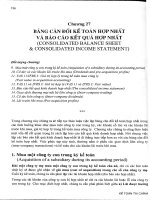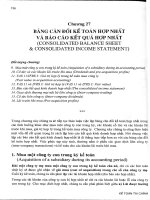Gíao trình kế toán bằng tiếng anh ch04
Bạn đang xem bản rút gọn của tài liệu. Xem và tải ngay bản đầy đủ của tài liệu tại đây (2.04 MB, 50 trang )
Chapter 4
Activity-Based
Costing
Learning Objectives
After studying this chapter, you should be able to:
[1] Recognize the difference between traditional costing and activity-based costing.
[2] Identify the steps in the development of an activity-based costing system.
[3] Know how companies identify the activity cost pools used in activity-based
costing.
[4] Know how companies identify and use cost drivers in activity-based costing.
[5] Understand the benefits and limitations of activity-based costing.
[6] Differentiate between value-added and non–value added activities.
[7] Understand the value of using activity levels in activity-based costing.
[8] Apply activity-based costing to service industries.
4-1
Preview of Chapter 4
Managerial Accounting
Sixth Edition
Weygandt Kimmel Kieso
4-2
Traditional Costing and Activity-Based Costing
Traditional Costing Systems
Allocates overhead using a single predetermined rate.
►
Job order costing: direct labor cost may be the
relevant activity base.
►
Process costing: machine hours may be the relevant
activity base.
Assumption was satisfactory when direct labor was a
major portion of total manufacturing costs.
►
Wide acceptance of a high correlation between direct
labor and overhead costs.
4-3
LO1 Recognize the difference between traditional costing and activity-based costing.
Traditional Costing and Activity-Based Costing
The Need for a New Approach
4-4
Tremendous change in manufacturing and service
industries.
Decrease in amount of direct labor usage.
Significant increase in total overhead costs.
Inappropriate to use plant-wide predetermined
overhead rates when a lack of correlation exists.
Complex manufacturing processes may require
multiple allocation bases; this approach is called
Activity-Based Costing (ABC).
Illustration 4-1
Traditional one-stage
costing system
LO1 Recognize the difference between traditional costing and activity-based costing.
Traditional Costing and Activity-Based Costing
Activity-Based Costing
4-5
Allocates overhead to multiple activity cost pools and
Assigns the activity cost pools to products or services by
means of cost drivers.
LO1 Recognize the difference between traditional costing and activity-based costing.
Traditional Costing and Activity-Based Costing
Activity-Based Costing
Activity: any event, action, transaction, or work sequence
that causes a cost to be incurred in producing a product or
providing a service.
Activity Cost Pool: a distinct type of activity. For
example: ordering materials or setting up machines.
Cost Drivers: any factors or activities that have a direct
cause-effect relationship with the resources consumed.
4-6
LO1 Recognize the difference between traditional costing and activity-based costing.
Traditional Costing and Activity-Based Costing
Activity-Based Costing
ABC allocates overhead costs in two stages:
Stage 1: Overhead costs are allocated to activity cost pools.
Stage 2: Assigns overhead allocated to the activity cost
pools to products, using cost drivers.
4-7
The more complex a product’s manufacturing operation, the
more activities and cost drivers are likely to be present.
LO1 Recognize the difference between traditional costing and activity-based costing.
Traditional Costing and Activity-Based Costing
Activity-Based Costing
4-8
Illustration 4-2
Activities and related cost drivers
LO1 Recognize the difference between traditional costing and activity-based costing.
Traditional Costing and Activity-Based Costing
Activity-Based Costing
4-9
Illustration 4-3
ABC system design—Lift Jack Company
LO1 Recognize the difference between traditional costing and activity-based costing.
Indicate whether the following statements are true or false.
1. A traditional costing system allocates overhead by means of multiple
overhead rates.
2. Activity-based costing allocates overhead costs in a two-stage
process.
3. Direct material and direct labor costs are easier to trace to products
than overhead.
4. As manufacturing processes have become more automated, more
companies have chosen to allocate overhead on the basis of direct
labor costs.
5. In activity-based costing, an activity is any event, action, transaction,
or work sequence that incurs cost when producing a product.
Solution:
4-10
1. false.
2. true.
3. true.
4. false.
5. true.
LO1 Recognize the difference between traditional costing and activity-based costing.
Example of ABC Versus Traditional Costing
Activity-Based Costing
Involves the following four steps.
1. Identify and classify the activities involved in the manufacture
of specific products, and allocate overhead to cost pools.
2. Identify the cost driver that has a strong correlation to the
costs accumulated in the cost pool.
3. Compute the activity-based overhead rate for each cost
driver.
4. Assign overhead costs to products, using the overhead rates
determined for each cost pool (cost per driver).
4-11
LO2 Identify the steps in the development of an activity-based costing system.
Example of ABC Versus Traditional Costing
Illustration:
4-12
Atlas Company produces two products (abdominal trainers):
►
Ab Bench: a high volume item with sales totaling 25,000 units annually.
►
Ab Coaster: a low volume item with sales totaling 5,000 units annually.
Each product requires 1 hour of direct labor.
►
Total annual direct labor hours (DLH) 30,000 (25,000 + 5,000)
►
Direct labor cost $12 per unit for each product
Expected annual manufacturing overhead costs $900,000.
Direct materials cost:
►
Ab Bench - $40 per unit
►
Ab Coaster - $30 per unit
Required: Calculate unit
costs under ABC.
LO2 Identify the steps in the development of an activity-based costing system.
Example of ABC Versus Traditional Costing
Illustration:
Manufacturing costs
Ab Bench
Ab Coaster
$40
$30
Direct labor
12
12
Overhead
30
30
$82
$72
Direct materials
Total unit cost
* Overhead rate = $900,000/30,000 DLH = $30 per DLH
Overhead = ($30 X 1 hr. = $30)
4-13
LO2 Identify the steps in the development of an activity-based costing system.
Example of ABC Versus Traditional Costing
Identify and Classify Activities and Allocate
Overhead to Cost Pools (Step 1)
Overhead costs are assigned directly to the appropriate activity
cost pool.
Illustration 4-4
4-14
LO3 Know how companies identify the activity cost pools used in activity-based costing.
Example of ABC Versus Traditional Costing
Identify Cost Drivers (Step 2)
Cost driver must accurately measure the actual consumption of the
activity by the various products.
Illustration 4-5
4-15
LO4 Know how companies identify and use cost drivers in activity-based costing.
Example of ABC Versus Traditional Costing
Compute Overhead Rates (Step 3)
Next, the company computes an activity-based overhead rate per
cost driver.
Illustration 4-6
Illustration 4-7
4-16
LO4 Know how companies identify and use cost drivers in activity-based costing.
Example of ABC Versus Traditional Costing
Assign Overhead Cost to Products (Step 4)
In assigning overhead costs, it is necessary to know the expected
use of cost drivers for each product. Because of its low volume,
Ab Coaster requires more set-ups and inspections than Ab Bench.
Illustration 4-8
4-17
LO4 Know how companies identify and use cost drivers in activity-based costing.
Example of ABC Versus Traditional Costing
Assign Overhead Cost to Products (Step 4)
To assign overhead costs, Atlas multiplies the activity-based
overhead rates per cost driver (Ill. 4-7) by the number of cost
drivers expected to be used per product (Ill. 4-8).
Illustration 4-9
4-18
LO4 Know how companies identify and use cost drivers in activity-based costing.
Example of ABC Versus Traditional Costing
Assign Overhead Cost to Products (Step 4)
To assign overhead costs, Atlas multiplies the activity-based
overhead rates per cost driver (Ill. 4-7) by the number of cost
drivers expected to be used per product (Ill. 4-8).
Illustration 4-9
4-19
LO4 Know how companies identify and use cost drivers in activity-based costing.
Example of ABC Versus Traditional Costing
Comparing Unit Costs
Illustration 4-10
A likely consequence of the differences in assigning overhead is
that Atlas has been overpricing the Ab Bench and possibly losing
market share to competitors. It also has been sacrificing profitability
by underpricing the Ab Coaster.
4-20
LO4 Know how companies identify and use cost drivers in activity-based costing.
Example of ABC Versus Traditional Costing
Comparing Unit Costs
4-21
Illustration 4-11
LO4 Know how companies identify and use cost drivers in activity-based costing.
Casey Company has five activity cost pools and two products. It
expects to produce 200,000 units of its automobile scissors jack and
80,000 units of its truck hydraulic jack. Having identified its activity cost
pools and the cost drivers for each cost pool, Casey Company
accumulated the following data relative to those activity cost pools and
cost drivers.
4-22
LO4 Know how companies identify and use cost drivers in activity-based costing.
Casey Company has five activity cost pools and two products. It
expects to produce 200,000 units of its automobile scissors jack and
80,000 units of its truck hydraulic jack. Having identified its activity cost
pools and the cost drivers for each cost pool, Casey Company
accumulated the following data relative to those activity cost pools and
cost drivers.
Using the above data, do the following.
a. Prepare a schedule showing the computations of the activitybased overhead rates per cost driver.
b. Prepare a schedule assigning each activity’s overhead cost to the
two products.
c. Compute the overhead cost per unit for each product.
d. Comment on the comparative overhead cost per unit.
4-23
LO4 Know how companies identify and use cost drivers in activity-based costing.
a. Prepare a schedule showing the computations of the activity-based overhead rates per cost driver.
4-24
LO4 Know how companies identify and use cost drivers in activity-based costing.
b. Prepare a schedule assigning each activity’s overhead cost
to the two products.
4-25
LO4









